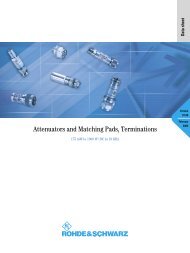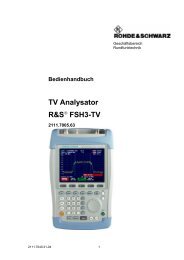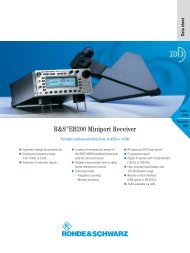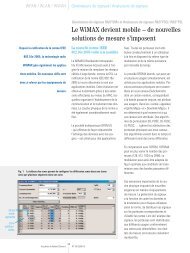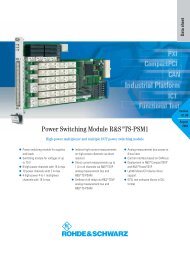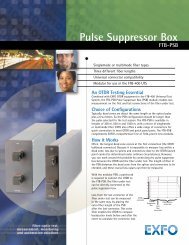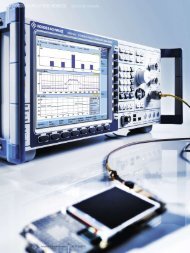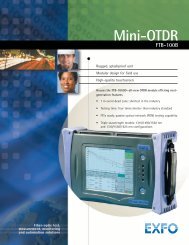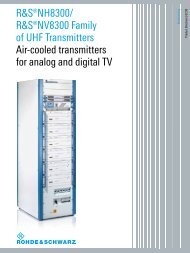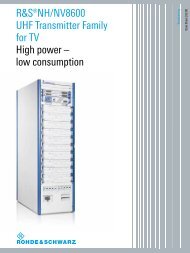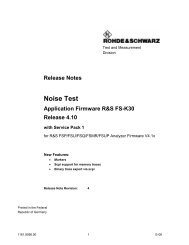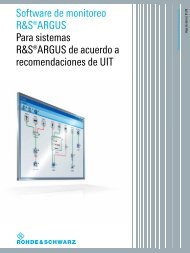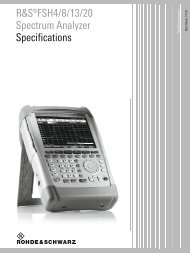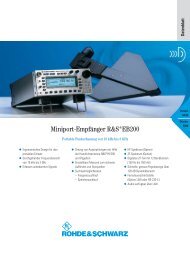R&S®CA100 PC-Based Signal Analysis and ... - Rohde & Schwarz
R&S®CA100 PC-Based Signal Analysis and ... - Rohde & Schwarz
R&S®CA100 PC-Based Signal Analysis and ... - Rohde & Schwarz
You also want an ePaper? Increase the reach of your titles
YUMPU automatically turns print PDFs into web optimized ePapers that Google loves.
R&<strong>S®CA100</strong><br />
<strong>PC</strong>-<strong>Based</strong> <strong>Signal</strong> <strong>Analysis</strong> <strong>and</strong><br />
<strong>Signal</strong> Processing Software<br />
St<strong>and</strong>alone software solution<br />
Radiomonitoring & Radiolocation<br />
Product Brochure | 01.00
R&<strong>S®CA100</strong><br />
<strong>PC</strong>-<strong>Based</strong> <strong>Signal</strong><br />
<strong>Analysis</strong> <strong>and</strong> <strong>Signal</strong><br />
Processing Software<br />
At a glance<br />
R&<strong>S®CA100</strong> is a st<strong>and</strong>alone software solution for<br />
analysis, classification, demodulation <strong>and</strong> decoding<br />
of digital <strong>and</strong> analog IF signals. The software<br />
provides powerful signal analysis <strong>and</strong> signal<br />
processing functions running on a Windows <strong>PC</strong>. If<br />
connected to modern <strong>Rohde</strong> & <strong>Schwarz</strong> monitoring<br />
receivers with internal digital downconverters (DDC),<br />
e.g. R&S®ESMD, up to four signals can be processed<br />
in parallel.<br />
R&<strong>S®CA100</strong> provides a signal overview using a high-speed<br />
spectrum/waterfall display; it supports both the monitoring<br />
of known signals (demodulation <strong>and</strong> decoding to content<br />
level) <strong>and</strong> surveillance/search operation by automatically<br />
detecting signals of interest <strong>and</strong> performing a classification<br />
(recognition of modulation type <strong>and</strong> transmission system/<br />
code).<br />
For complex (very dense, weak or disturbed) signal scenarios,<br />
the user can override the automatic signal processing<br />
<strong>and</strong> manually set the classifier or demodulator/decoder to<br />
the signal of interest. An additional time domain analysis<br />
function makes it possible to manually measure technical<br />
signal parameters.<br />
The detect, search <strong>and</strong> classify application provides a fully<br />
automatic mode to monitor a frequency range, detect all<br />
signals of interest, classify, demodulate, decode these signals<br />
<strong>and</strong> store the results for later processing.<br />
<strong>Signal</strong> data (digital IF) can be recorded on the computer<br />
hard disk or on external AMREC devices (e.g. R&S®GX460)<br />
<strong>and</strong> replayed for processing.<br />
Key facts<br />
❙❙Automatic interception <strong>and</strong> monitoring of complete<br />
signal scenarios<br />
❙❙Powerful classifier <strong>and</strong> extensive signal processing library<br />
with demodulators <strong>and</strong> decoders<br />
❙❙Configurable detection of fixed frequency <strong>and</strong> burst<br />
signals with subsequent automatic processing of<br />
detected signals (including content recovery depending<br />
on signal type)<br />
❙❙Modular scalability from one-channel through fourchannel<br />
signal processing solution (multichannel<br />
capability available if connected to a <strong>Rohde</strong> & <strong>Schwarz</strong><br />
monitoring receiver/digital direction finder with internal<br />
digital downconverters, e.g. R&S®ESMD/EB510/EB500/<br />
DDF255/DDF205)<br />
❙❙Open interface for independent extension of signal<br />
processing capabilities by the user<br />
❙❙Manual signal measurement in line with ITU-R SM.1600<br />
❙❙<strong>Signal</strong> recording <strong>and</strong> replaying on/from hard disk<br />
Four signals of an 80 MHz signal<br />
scenario provided by an R&S®ESMD<br />
wideb<strong>and</strong> monitoring receiver are<br />
classified, demodulated <strong>and</strong> decoded<br />
in parallel.<br />
2
R&<strong>S®CA100</strong><br />
<strong>PC</strong>-<strong>Based</strong> <strong>Signal</strong><br />
<strong>Analysis</strong> <strong>and</strong> <strong>Signal</strong><br />
Processing Software<br />
Benefits <strong>and</strong><br />
key features<br />
Large variety of sources for signal acquisition<br />
❙❙Processing of digital IF data<br />
❙❙Spectrum/waterfall representation of signal data<br />
❙❙<strong>Signal</strong> recording <strong>and</strong> replaying on/from hard disk<br />
❙❙Processing of multiple signals<br />
▷▷<br />
page 4<br />
Quick results with automatic classification<br />
❙❙Powerful R&S®AMMOS classification unit<br />
❙❙Comprehensive library of demodulators <strong>and</strong> decoders<br />
▷▷<br />
page 5<br />
Demodulators <strong>and</strong> decoders for a wide range of<br />
use cases<br />
❙❙Manual or automatic demodulation <strong>and</strong> decoding<br />
❙❙Customer-specific decoders <strong>and</strong> demodulators<br />
▷▷<br />
page 6<br />
Fast <strong>and</strong> reliable simultaneous processing of<br />
multiple signals<br />
❙❙Manual parallel processing of multiple signals<br />
❙❙Automatic detection of fixed frequency <strong>and</strong> burst signals<br />
for fast <strong>and</strong> dependable results<br />
❙❙Detection threshold <strong>and</strong> ignoring of frequency ranges<br />
❙❙Detection using a scanning receiver<br />
▷▷<br />
page 7<br />
High-speed spectral shape search<br />
❙❙Fast recognition of signals by spectral matching<br />
❙❙Enhancement of detect, search <strong>and</strong> classify workflows by<br />
detection list filtering<br />
❙❙Spectral collector <strong>and</strong> spectral detector trainer<br />
▷▷<br />
page 9<br />
Reduced user workload due to automatic<br />
processing of detected signals<br />
❙❙Automatic monitoring of wide frequency ranges<br />
❙❙Fully automatic signal processing with user-defined rules<br />
via script editor<br />
▷▷<br />
page 12<br />
Going into detail with manual measurements<br />
❙❙Manual measurements of emission characteristics<br />
❙❙Emission analysis<br />
▷▷<br />
page 14<br />
<strong>Analysis</strong> of signal scenarios in line with<br />
ITU‐R SM.1600<br />
❙❙Technical parameters of unknown signals<br />
❙❙Recognition of known or st<strong>and</strong>ardized methods<br />
❙❙Advanced visualization<br />
▷▷<br />
page 15<br />
Diverse opportunities for user-specific expansion<br />
❙❙Open programming interface for integration of userspecific<br />
modules<br />
❙❙Integration of a wide variety of user-programmed module<br />
types<br />
▷▷<br />
page 17<br />
<strong>Rohde</strong> & <strong>Schwarz</strong> R&<strong>S®CA100</strong> <strong>PC</strong>-<strong>Based</strong> <strong>Signal</strong> <strong>Analysis</strong> <strong>and</strong> <strong>Signal</strong> Processing Software 3
Large variety of<br />
sources for signal<br />
acquisition<br />
Processing of digital IF data<br />
R&<strong>S®CA100</strong> processes digital IF signal data, covering the<br />
following:<br />
❙❙Online digital IF data provided by various<br />
<strong>Rohde</strong> & <strong>Schwarz</strong> receivers/digital direction finders<br />
❙❙Online analog IF data digitized via sound card<br />
❙❙Offline replay of digital IF data (R&S®AMMOS IF format);<br />
the signal sample can be an IF file replayed from local<br />
hard disk or from an external AMREC recording/replaying<br />
device (e.g. R&S®GX460)<br />
❙❙Offline replay of WAV file<br />
Spectrum/waterfall representation of signal data<br />
The frequency range is presented using a realtime waterfall<br />
with up to 1000 lines/s. <strong>Signal</strong> attributes can be measured<br />
by using time <strong>and</strong> frequency axis cursors.<br />
<strong>Signal</strong> recording <strong>and</strong> replaying on/from hard disk<br />
By activating the IF recording, a signal sample is stored on<br />
the computer hard disk for later IF replay or IF export.<br />
Alternatively a connected AMREC recording/replaying device<br />
(e.g. R&S®GX460) can be used for data storage.<br />
By using an audio demodulator, (analog) emissions can<br />
be listened to <strong>and</strong> recorded to WAV files on the computer<br />
hard disk or on a connected AMREC recording/replaying<br />
device.<br />
Processing of multiple signals<br />
If connected to a <strong>Rohde</strong> & <strong>Schwarz</strong> monitoring receiver<br />
with internal digital downconverters (DDC) such as the<br />
R&S®ESMD, R&<strong>S®CA100</strong> is able to process up to four 1)<br />
downconverted signals in parallel. The center frequency<br />
<strong>and</strong> b<strong>and</strong>width of each DDC can be set independently<br />
within the limits of the processable realtime b<strong>and</strong>width of<br />
the monitoring receiver or digital direction finder.<br />
1)<br />
Depends on monitoring receiver/digital direction finder type.<br />
The R&S®ESMD provides an 80 MHz spectrum. Four DDCs were set to downconvert four signals. These signals are indicated with different color frames<br />
<strong>and</strong> will be processed in parallel by R&<strong>S®CA100</strong>.<br />
4
Quick results<br />
with automatic<br />
classification<br />
Powerful R&S®AMMOS classification unit<br />
R&<strong>S®CA100</strong> contains the powerful R&S®AMMOS classification<br />
unit for the HF <strong>and</strong> VHF/UHF frequency ranges <strong>and</strong><br />
can recognize the modulation type <strong>and</strong> transmission system<br />
of a huge variety of analog <strong>and</strong> digital signals. A list of<br />
supported modulation types included in the R&S®AMMOS<br />
classification unit is provided in the data sheet. This list will<br />
be continuously exp<strong>and</strong>ed.<br />
The classification algorithm delivers a segmentation <strong>and</strong><br />
modulation analysis result. The segmentation process determines<br />
the accurate center frequency <strong>and</strong> b<strong>and</strong>width of<br />
the signal. The modulation analysis determines the modulation<br />
type <strong>and</strong> all important modulation parameters (symbol<br />
rate, frequency shift, etc.).<br />
Comprehensive library of demodulators <strong>and</strong><br />
decoders<br />
The classifier results are used to automatically parameterize<br />
a demodulator from the R&S®AMMOS demodulation<br />
library. The resulting symbol/bitstream can be analyzed of<br />
transmission system recognition <strong>and</strong> can be decoded by<br />
using the decoders of the R&S®AMMOS decoding library.<br />
Depending on the transmission system, the corresponding<br />
decoder output will be displayed.<br />
Customer-specific decoders that are developed with the<br />
R&S®GX400ID decoder development equipment <strong>and</strong> installed<br />
on R&<strong>S®CA100</strong> are also used in the classification<br />
process. Symbol/bitstream data can be exported for bitstream<br />
analysis with R&S®CA250.<br />
CLOVER system classification <strong>and</strong> visualization example.<br />
Classification, demodulation <strong>and</strong><br />
decoding.<br />
<strong>Rohde</strong> & <strong>Schwarz</strong> R&<strong>S®CA100</strong> <strong>PC</strong>-<strong>Based</strong> <strong>Signal</strong> <strong>Analysis</strong> <strong>and</strong> <strong>Signal</strong> Processing Software 5
Demodulators <strong>and</strong><br />
decoders for a wide<br />
range of use cases<br />
Manual or automatic demodulation <strong>and</strong> decoding<br />
Demodulators <strong>and</strong> decoders can be set manually by the<br />
operator or automatically by the R&<strong>S®CA100</strong> modulation<br />
<strong>and</strong> transmission system classifier. The symbol viewer is<br />
used for visualizing symbol data. For a list of the demodulators<br />
<strong>and</strong> decoders included in R&<strong>S®CA100</strong>, see the data<br />
sheet (PD 3606.9340.22). This list will be continuously<br />
exp<strong>and</strong>ed.<br />
Customer-specific decoders <strong>and</strong> demodulators<br />
Customer-specific decoders (developed with the<br />
R&S®GX400ID decoder development equipment) <strong>and</strong><br />
customer-specific demodulators can be installed on<br />
R&<strong>S®CA100</strong> to exp<strong>and</strong> the demodulation/decoding<br />
capability (see page 17).<br />
Symbol view of multichannel PSK signal.<br />
Meteosat weather fax.<br />
Demodulation <strong>and</strong> decoding of a Piccolo MK6 signal.<br />
6
Fast <strong>and</strong> reliable<br />
simultaneous<br />
processing of<br />
multiple signals<br />
R&<strong>S®CA100</strong> has an automatic detector that enables<br />
the user to scan or monitor frequency ranges<br />
automatically for fixed frequency <strong>and</strong> burst signals.<br />
Manual parallel processing of multiple signals<br />
Frequently, the realtime b<strong>and</strong>width of a monitoring receiver<br />
contains multiple signals simultaneously. If R&<strong>S®CA100</strong><br />
is connected to a <strong>Rohde</strong> & <strong>Schwarz</strong> monitoring receiver/<br />
digital direction finder with internal digital downconverters,<br />
e.g. R&S®ESMD/EB510/EB500/DDF255/DDF205, the user<br />
can downconvert multiple signals <strong>and</strong> then manually process<br />
them in parallel. The individual DDCs can set their<br />
center frequencies <strong>and</strong> b<strong>and</strong>widths within the limits of the<br />
processable realtime b<strong>and</strong>width of the monitoring receiver.<br />
The downconverted signals are processed by the user with<br />
audio demodulation, classification, demodulation/decoding<br />
<strong>and</strong> recording.<br />
Manual processing of multiple signals.<br />
<strong>Rohde</strong> & <strong>Schwarz</strong> R&<strong>S®CA100</strong> <strong>PC</strong>-<strong>Based</strong> <strong>Signal</strong> <strong>Analysis</strong> <strong>and</strong> <strong>Signal</strong> Processing Software 7
Automatic detection of fixed frequency <strong>and</strong> burst<br />
signals for fast <strong>and</strong> dependable results<br />
In addition to its manual mode, R&<strong>S®CA100</strong> provides a<br />
high level of automation for detecting <strong>and</strong> monitoring fixed<br />
frequency <strong>and</strong> burst signals. A detection result is generated<br />
for every detected signal that meets the predefined<br />
selection criteria (signal duration, b<strong>and</strong>width, level, etc.).<br />
The detection results are cyclically compared with the<br />
signal scenario from the previous processing cycles.<br />
The following events are reported:<br />
❙❙New signal (signal over threshold for first time)<br />
❙❙Change in characteristic of a known signal (activity<br />
status, change in level, b<strong>and</strong>width or center frequency)<br />
❙❙Inactive signal (signal level falls below detection<br />
threshold)<br />
❙❙End of signal reached<br />
Detected signals are classified automatically.<br />
For content recovery, the user can manually select signals<br />
from the list of detected/classified signals <strong>and</strong> start demodulation/decoding<br />
with the measured parameters. The<br />
user can also configure a rule-based automated workflow<br />
that independently h<strong>and</strong>les the processing of the relevant<br />
signals (see page 12).<br />
Detection threshold <strong>and</strong> ignoring of frequency<br />
ranges<br />
The automatically computed detection threshold adapts<br />
to the variable noise floor that is typical of a specific frequency<br />
range.<br />
In scenarios where certain signals or frequency ranges are<br />
of no interest, a list of frequency ranges to ignore can be<br />
included in the detector algorithms. The detectors will then<br />
stop generating messages for signals in these ranges.<br />
Detection using a scanning receiver<br />
For signal detection, the receiver is operated in scan<br />
mode, which means it can cover any frequency range. The<br />
automatic detector operates in the scan spectrum <strong>and</strong><br />
detects signals as described above.<br />
To process (e.g. classify/demodulate/decode) detected signals<br />
automatically, the monitoring receivers' internal digital<br />
downconverters are used to extract signals if the receiver<br />
is in fixed frequency mode.<br />
The automatic detection functionality<br />
informs the user about signals<br />
<strong>and</strong> events of potential interest.<br />
8
High-speed spectral<br />
shape search<br />
R&<strong>S®CA100</strong> excels in detecting <strong>and</strong> identifying<br />
spectral shapes of interest within a wide, densely<br />
populated scenario.<br />
Fast recognition of signals by spectral matching<br />
The spectral shape detector is designed to search for<br />
known <strong>and</strong> unknown signals by performing spectral pattern<br />
matching. It is very fast <strong>and</strong> customizable (i.e. it<br />
searches for signals of interest as specified by the user).<br />
The decisions of the matching algorithm are based on<br />
many criteria within a comprehensive decision matrix,<br />
which allows the similarities between input signals <strong>and</strong><br />
shape description sets to be reliably assessed. Owing to<br />
this unique algorithm, the spectral shape detector can operate<br />
effectively across wide frequency ranges, dense signal<br />
scenarios, <strong>and</strong> even under harsh radio conditions.<br />
Fast recognition of spectral shapes has two other<br />
advantages:<br />
❙❙Known shapes of interest can be captured quickly<br />
(effective search)<br />
❙❙Known shapes that are not of interest can be ignored<br />
(efficient search)<br />
Both capabilities will significantly speed up the work of a<br />
surveillance operator <strong>and</strong> are greatly beneficial for quick<br />
search applications.<br />
Thanks to its high speed, the use of predefined shapes <strong>and</strong><br />
the new search algorithm, the spectral shape detector provides<br />
the following features:<br />
❙❙Rapid: It accelerates spectral search by analyzing 1000<br />
spectral shapes in less than 1 s<br />
❙❙Robust: It excels in dealing with varying <strong>and</strong> complex<br />
signal scenarios, by considering noise, fading <strong>and</strong><br />
shifting sampling rates<br />
❙❙Reliable: It aims to effectively detect signals with distinct<br />
spectral shapes (e.g. CW, AM-DSB, multichannel <strong>and</strong><br />
FSK signals) <strong>and</strong> also improves the reliability by feeding<br />
the recognized spectral shapes to the baseb<strong>and</strong> classifier<br />
❙❙Reconfigurable: It enables users to define the signal<br />
categories <strong>and</strong> configurations that suit their own whishes<br />
<strong>and</strong> needs<br />
<strong>Rohde</strong> & <strong>Schwarz</strong> R&<strong>S®CA100</strong> <strong>PC</strong>-<strong>Based</strong> <strong>Signal</strong> <strong>Analysis</strong> <strong>and</strong> <strong>Signal</strong> Processing Software 9
Enhancement of detect, search <strong>and</strong> classify<br />
workflows by detection list filtering<br />
The spectral shape detector is especially useful for the following<br />
applications <strong>and</strong> is designed to obtain optimized<br />
results:<br />
❙❙Filtering spectral shapes of interest (e.g. identifying<br />
only those signals with a spectral shape that matches<br />
the shapes of signals of interest) before a baseb<strong>and</strong><br />
classifier/demodulator/decoder optionally starts analyzing<br />
<strong>and</strong> processing them in more detail<br />
❙❙Filtering out known <strong>and</strong> even unknown spectral shape<br />
types that are not of interest <strong>and</strong> do not need to be<br />
analyzed or processed in depth<br />
❙❙Extending the list of recognizable signals based on userdefined<br />
categories<br />
The detector is provided with a database of spectral<br />
shapes. This is the spectral reference library. The patterns<br />
in the database can either be specific user-defined signal<br />
types with corresponding parameters, or predefined within<br />
the detector as generic signal types (i.e. CW, AM‐DSB,<br />
multichannel <strong>and</strong> FSK signals).<br />
To increase the robustness of the detector, several different<br />
instances of the same signal category are gathered<br />
<strong>and</strong> processed by the spectral collector. These are used by<br />
the spectral detector trainer, which “learns” to recognize<br />
<strong>and</strong> define these shapes in order to develop the spectral<br />
reference library. After this “training” phase has been completed,<br />
the detector is able to work with the live spectrum<br />
(the receiver can be in fixed frequency or scanning mode).<br />
The conventional energy detector is combined with a high-performance spectral shape detector to enhance the<br />
signal search <strong>and</strong> recognition process. The lower screenshot shows the result of matching the library of generic<br />
<strong>and</strong> user-defined signal types by using the spectral shape detector.<br />
10
Spectral collector <strong>and</strong> spectral detector trainer<br />
The spectral collector is a fully automatic application for<br />
identifying <strong>and</strong> collecting a reasonable number of signals<br />
(based on live or offline spectrum) that are suited for training<br />
purposes. <strong>Based</strong> on an automatic algorithm, it selects<br />
<strong>and</strong> gathers a number of spectral shapes that are representative<br />
of the signal of interest. These spectral shapes<br />
vary because they have been computed at different times<br />
(i.e. within a few seconds of the selection time). The spectral<br />
collector also manages the repeated collection of different<br />
emissions associated with the same signal category.<br />
The spectral detector trainer is a st<strong>and</strong>alone application<br />
for extracting relevant spectral information <strong>and</strong> identifying<br />
certain signal types based on a set of spectral sample<br />
data. The extracted spectral features define a specific category<br />
of signals. This information is used by the detector<br />
to recognize signals with similar spectral characteristics<br />
during a spectral shape search.<br />
In order to train the detector, the user decides which<br />
signal types are of interest, collects the corresponding<br />
sample data <strong>and</strong> defines the desired signal categories. It is<br />
also possible to automatically create a training collection<br />
using the spectral detector trainer. Each signal category<br />
is represented by a reasonable number of spectral shapes<br />
(approx. 30) <strong>and</strong> defined in the spectral reference library.<br />
The training is carried out based on a list of shape-describing<br />
features derived from the signals within the spectral<br />
reference library. In order to achieve a more reliable detection,<br />
the set of reference shapes used for training should<br />
include examples of degraded signals. This makes shape<br />
detection more robust against negative influences such as<br />
noise <strong>and</strong> fading.<br />
<strong>Based</strong> on the input data from the spectral reference library,<br />
the spectral detector trainer creates a profile for<br />
the detector for each signal category. Using an automatic<br />
decision algorithm, the detector evaluates how well each<br />
detected signal matches the characteristics of the trained<br />
categories.<br />
Spectral detector trainer.<br />
<strong>Rohde</strong> & <strong>Schwarz</strong> R&<strong>S®CA100</strong> <strong>PC</strong>-<strong>Based</strong> <strong>Signal</strong> <strong>Analysis</strong> <strong>and</strong> <strong>Signal</strong> Processing Software 11
Reduced user<br />
workload due<br />
to automatic<br />
processing of<br />
detected signals<br />
R&<strong>S®CA100</strong> combines signal detection with<br />
configurable, automatic processing (classification,<br />
demodulation, decoding, content recovery,<br />
recording).<br />
Automatic monitoring of wide frequency ranges<br />
The most impressive benefit of R&<strong>S®CA100</strong> is the combination<br />
of automatic detection <strong>and</strong> classification with fully<br />
automated processing of signals (demodulation, decoding,<br />
recording). This allows R&<strong>S®CA100</strong> to independently monitor<br />
a wide frequency range <strong>and</strong> eliminate many routine<br />
tasks for the user.<br />
The user defines a set of rules. For each signal, these rules<br />
are used to automatically <strong>and</strong> independently perform the<br />
following actions:<br />
❙ Event triggering: The signal's technical parameters are<br />
associated with signal types of special interest. An event<br />
notification is generated <strong>and</strong> sent to the user immediately<br />
after recognition<br />
❙ Recording: A snapshot of the signal (with predefinable<br />
length) is to be saved for subsequent processing.<br />
The digital IF is saved on a recording/replaying unit. It<br />
performs IF recording of the fixed frequency signal as<br />
well as wideb<strong>and</strong> IF recording (with defined duration)<br />
❙ Demodulation or demodulation/decoding: If the<br />
demodulators/decoders for the recognized transmission<br />
system are found in the library of R&<strong>S®CA100</strong>, then<br />
they are configured with the measured parameters <strong>and</strong><br />
started. The signal content is recovered <strong>and</strong> saved. The<br />
maximum duration of the content snapshot can be<br />
predefined. Automatic processing includes the following:<br />
■ Audio demodulation: performs audio demodulation of<br />
the fixed frequency signal <strong>and</strong> saves the audio data<br />
■ Digital demodulation: performs digital demodulation of<br />
the fixed frequency signal <strong>and</strong> saves the symbol stream<br />
data<br />
■ Digital demodulation/decoding: performs digital<br />
demodulation/decoding of the fixed frequency signal<br />
<strong>and</strong> saves the content<br />
Application example for fully automatic signal processing<br />
<strong>Signal</strong> classified<br />
PACTOR III transmission<br />
system recognized?<br />
No<br />
Analog fixed frequency signal<br />
(AM, FM, SSB) recognized?<br />
Yes<br />
Start audio demodulation with<br />
appropriate modulation type<br />
(AM, FM, SSB) <strong>and</strong> record audio signal<br />
(5 s duration)<br />
Yes<br />
Perform digital demodulation/decoding<br />
of signal <strong>and</strong> save content<br />
(until end of signal)<br />
The user can simultaneously intercept various signal types with ¸CA100. Example: for detected analog signals, the audio data is recorded (5 s duration).<br />
Detected digital PACTOR III signals are decoded until the end of the signal.<br />
12
Fully automatic signal processing with userdefined<br />
rules via script editor<br />
R&<strong>S®CA100</strong> performs fully automatic processing using<br />
JavaScript scripts to trigger actions that control what is<br />
recorded or processed. These scripts make it possible to<br />
define conditions or criteria based on the relevant parameters.<br />
When these conditions are met, the script triggers<br />
the corresponding actions (predefined by the user). The<br />
script can also decide when a signal will be skipped <strong>and</strong><br />
define how long a signal will be recorded if an action is<br />
triggered.<br />
R&S®ScriptEditor provides an environment in which such<br />
scripts can be written, tested <strong>and</strong> debugged. This tool<br />
has been designed to allow a straightforward approach to<br />
script development <strong>and</strong> to reduce the effort involved in developing<br />
the scripts.<br />
General overview of the R&S®ScriptEditor GUI, with the input fields that act as triggers (left), the central scripting area where analysis is performed (center)<br />
<strong>and</strong> windows where analysis results are shown (right).<br />
<strong>Rohde</strong> & <strong>Schwarz</strong> R&<strong>S®CA100</strong> <strong>PC</strong>-<strong>Based</strong> <strong>Signal</strong> <strong>Analysis</strong> <strong>and</strong> <strong>Signal</strong> Processing Software 13
Going into detail<br />
with manual<br />
measurements<br />
Manual measurements of emission characteristics<br />
Manual measurements of emission characteristics (b<strong>and</strong>width,<br />
duration, S/N ratio, level) can be performed with<br />
measurement cursors in the zoomable spectrum. The filter<br />
b<strong>and</strong>width is automatically adapted to filter out all disturbing<br />
out-of-b<strong>and</strong> emissions <strong>and</strong> noise.<br />
Emission analysis<br />
Emissions are analyzed using the time domain analysis<br />
functionality of R&<strong>S®CA100</strong>. Zoomable level, envelope,<br />
frequency, phase <strong>and</strong> spectrum plots make it possible<br />
to measure technical parameters such as level range,<br />
frequency shift <strong>and</strong> symbol rate.<br />
Spectrum, time analysis <strong>and</strong> digital modulation.<br />
14
<strong>Analysis</strong> of signal<br />
scenarios in line<br />
with ITU‐R SM.1600<br />
Technical parameters of unknown signals<br />
R&<strong>S®CA100</strong> covers the measurement methods specified<br />
in the ITU-R SM.1600 recommendation. For unknown<br />
signals, it offers a variety of representations <strong>and</strong> tools for<br />
analyzing <strong>and</strong> measuring technical parameters such as<br />
b<strong>and</strong>width, symbol rate, number of tones, tone spacing,<br />
shift, modulation index, length of guard interval, number<br />
of channels, signal duration, symbol valency <strong>and</strong> modulation<br />
type.<br />
Recognition of known or st<strong>and</strong>ardized methods<br />
For known or st<strong>and</strong>ardized methods (GSM, DECT, CDMA,<br />
etc.), correlation <strong>and</strong> pattern analysis techniques are available.<br />
The tools of R&<strong>S®CA100</strong> allow quick recognition of<br />
preambles, training sequences <strong>and</strong> synchronization words<br />
of known methods.<br />
QAM16 constellation diagram.<br />
Spectrum <strong>and</strong> autocorrelation<br />
diagram.<br />
<strong>Rohde</strong> & <strong>Schwarz</strong> R&<strong>S®CA100</strong> <strong>PC</strong>-<strong>Based</strong> <strong>Signal</strong> <strong>Analysis</strong> <strong>and</strong> <strong>Signal</strong> Processing Software 15
Advanced visualization<br />
Time/frequency segmentation including filtering makes<br />
multichannel methods, noncontinuous emissions (bursts)<br />
<strong>and</strong> densely occupied signal scenarios easy to h<strong>and</strong>le.<br />
(Coded) orthogonal frequency division multiplex<br />
((C)OFDM) signals <strong>and</strong> methods using multiple modulation<br />
(e.g. AM‐FSK, FM‐FSK) can be easily measured <strong>and</strong><br />
analyzed.<br />
I/Q constellation diagrams <strong>and</strong> eye patterns are available<br />
for evaluating the measured parameters <strong>and</strong> the equalizer<br />
settings.<br />
Eye diagram of a multitone signal.<br />
Counting the channels of a<br />
PACTOR III signal.<br />
16
Diverse<br />
opportunities<br />
for user-specific<br />
expansion<br />
R&<strong>S®CA100</strong> provides the user with many ways<br />
to integrate user-programmed modules for signal<br />
processing (receiver driver, classifier, demodulator,<br />
decoder). As a result, users can deploy their own<br />
expertise in solutions in an independent manner.<br />
Open programming interface for integration of<br />
user-specific modules<br />
R&<strong>S®CA100</strong> supports various <strong>Rohde</strong> & <strong>Schwarz</strong> monitoring<br />
receivers/digital direction finders <strong>and</strong> has a comprehensive<br />
library of universal demodulators, decoders <strong>and</strong> transmission<br />
systems. Moreover, the user can program diverse signal<br />
processing modules for integration into <strong>and</strong> use with<br />
R&<strong>S®CA100</strong>.<br />
R&<strong>S®CA100</strong> provides a C++ interface for integrating user<br />
modules. Internally, user modules can contain components<br />
written in other programming languages such as<br />
C or MATLAB®.<br />
For example, the user can program <strong>and</strong> integrate<br />
user-specific decoders in C++ (upper<br />
screen) <strong>and</strong> visualize the results (lower screen).<br />
<strong>Rohde</strong> & <strong>Schwarz</strong> R&<strong>S®CA100</strong> <strong>PC</strong>-<strong>Based</strong> <strong>Signal</strong> <strong>Analysis</strong> <strong>and</strong> <strong>Signal</strong> Processing Software 17
Integration of a wide variety of user-programmed<br />
module types<br />
The following types of modules can be integrated:<br />
❙❙Receiver control: The user module functions as a receiver<br />
driver for a third-party monitoring receiver. It converts the<br />
receiver comm<strong>and</strong>s from R&<strong>S®CA100</strong> into comm<strong>and</strong>s for<br />
the other receiver <strong>and</strong> converts the receiver's digital IF<br />
into a format that R&<strong>S®CA100</strong> can process<br />
❙❙Universal demodulation: The user module exp<strong>and</strong>s the<br />
universal demodulator library available with R&<strong>S®CA100</strong>.<br />
<strong>Based</strong> on the IF data stream for a signal, it performs<br />
demodulation <strong>and</strong> provides a symbol stream for further<br />
processing<br />
❙❙Decoding: The user module exp<strong>and</strong>s the decoder<br />
library available with R&<strong>S®CA100</strong>. Using a universal<br />
demodulator in R&<strong>S®CA100</strong>, the user module functions<br />
as a decoder, i.e. it decodes the demodulated symbol<br />
data stream <strong>and</strong> recovers information content. This<br />
is applicable to decoders that have fixed modulation<br />
parameters but different encoding types for the content<br />
❙❙Transmission system: The user module exp<strong>and</strong>s the<br />
transmission system library available with R&<strong>S®CA100</strong>.<br />
It functions as an independent transmission system in<br />
order to demodulate/decode the IF data stream from<br />
a monitoring receiver <strong>and</strong> recover the content. This<br />
is necessary with signal types for which a solution<br />
involving a universal demodulator <strong>and</strong> decoder is not<br />
feasible. This includes adaptive transmission systems<br />
(e.g. CLOVER 2000 <strong>and</strong> PACTOR III) in which certain<br />
information in the decoded data stream must result<br />
in immediate changes to the demodulator settings,<br />
as well as transmission systems that require specific<br />
equalization/synchronization<br />
❙❙Classification: Instead of a universal demodulator<br />
module, the user can integrate a signal classification<br />
module. This user module functions as a modulation<br />
type/transmission system recognizer in addition to the<br />
<strong>Rohde</strong> & <strong>Schwarz</strong> classifier. Limitations: The output of the<br />
classifier is used for result vizualisation only<br />
18
Ordering information<br />
Designation Type Order No.<br />
<strong>PC</strong>-<strong>Based</strong> <strong>Signal</strong> <strong>Analysis</strong> <strong>and</strong> <strong>Signal</strong> Processing Software<br />
R&<strong>S®CA100</strong> 4102.0004.02<br />
(requires one of the following licensing options)<br />
Licensing options<br />
Licensing of R&<strong>S®CA100</strong> with USB Dongle R&<strong>S®CA100</strong>-U 4102.0062.02<br />
Licensing of R&<strong>S®CA100</strong> with SD Card Dongle R&<strong>S®CA100</strong>-S 4102.0079.02<br />
Licensing of R&<strong>S®CA100</strong> with Mini USB Dongle R&<strong>S®CA100</strong>-M 4102.0085.02<br />
Options for single-channel processing<br />
Processing of Digital <strong>Signal</strong>s R&<strong>S®CA100</strong>DM 4102.0091.02<br />
Classification 1) R&<strong>S®CA100</strong>CL 4102.0104.02<br />
Decoder Package Professional 1) R&<strong>S®CA100</strong>DEC 4102.0110.02<br />
Decoding of PACTOR II <strong>and</strong> PACTOR III 1) R&<strong>S®CA100</strong>PIII 4102.0133.02<br />
Decoding of CLOVER 1) R&<strong>S®CA100</strong>CV 4102.0140.02<br />
Decoding of CODAN 3012 1) R&<strong>S®CA100</strong>CO 4102.0156.02<br />
Decoding of Digital Mobile Communications 1) R&<strong>S®CA100</strong>DMC 4102.0162.02<br />
Options for multichannel processing<br />
Multichannel Processing R&<strong>S®CA100</strong>MCP 4102.0179.02<br />
Detection, Search <strong>and</strong> Classification of Fixed Frequency <strong>Signal</strong>s R&<strong>S®CA100</strong>DSC 4102.0185.02<br />
Spectral Shape Detector 2) R&<strong>S®CA100</strong>SDT 4102.0204.02<br />
Automatic Processing of Detected <strong>Signal</strong>s 2) R&<strong>S®CA100</strong>AP 4102.0191.02<br />
Options for signal analysis<br />
<strong>Analysis</strong> of <strong>Signal</strong> Scenarios in line with ITU-R SM.1600 R&<strong>S®CA100</strong>IS 4102.0210.02<br />
1)<br />
Requires R&<strong>S®CA100</strong>DM.<br />
2)<br />
Requires R&<strong>S®CA100</strong>DSC.<br />
Note:<br />
<strong>Rohde</strong> & <strong>Schwarz</strong> licenses for R&<strong>S®CA100</strong> are stored on a USB dongle, USB mini dongle or SD card. If the dongle or SD card is lost, stolen or misplaced,<br />
<strong>Rohde</strong> & <strong>Schwarz</strong> will not provide a replacement. All licenses stored on the missing device will have to be purchased again at full price.<br />
In the unlikely event that a USB dongle, USB mini dongle or SD card is corrupt or broken, it will be replaced by <strong>Rohde</strong> & <strong>Schwarz</strong> only if the defective<br />
device is returned to <strong>Rohde</strong> & <strong>Schwarz</strong>. A moderate fee will be charged for producing <strong>and</strong> sending the replacement.<br />
All options require the R&<strong>S®CA100</strong> base version.<br />
For data sheet, see PD 3606.9340.22 <strong>and</strong> www.rohde-schwarz.com.<br />
<strong>Rohde</strong> & <strong>Schwarz</strong> R&<strong>S®CA100</strong> <strong>PC</strong>-<strong>Based</strong> <strong>Signal</strong> <strong>Analysis</strong> <strong>and</strong> <strong>Signal</strong> Processing Software 19
Service that adds value<br />
❙ Worldwide<br />
❙ Local <strong>and</strong> personalized<br />
❙ Customized <strong>and</strong> flexible<br />
❙ Uncompromising quality<br />
❙ Long-term dependability<br />
About <strong>Rohde</strong> & <strong>Schwarz</strong><br />
<strong>Rohde</strong> & <strong>Schwarz</strong> is an independent group of companies<br />
specializing in electronics. It is a leading supplier of solutions<br />
in the fields of test <strong>and</strong> measurement, broadcasting,<br />
radiomonitoring <strong>and</strong> radiolocation, as well as secure<br />
communications. Established more than 75 years ago,<br />
<strong>Rohde</strong> & <strong>Schwarz</strong> has a global presence <strong>and</strong> a dedicated<br />
service network in over 70 countries. Company headquarters<br />
are in Munich, Germany.<br />
Environmental commitment<br />
❙❙Energy-efficient products<br />
❙❙Continuous improvement in environmental sustainability<br />
❙❙ISO 14001-certified environmental management system<br />
Certified Quality System<br />
ISO 9001<br />
<strong>Rohde</strong> & <strong>Schwarz</strong> GmbH & Co. KG<br />
www.rohde-schwarz.com<br />
Regional contact<br />
❙❙Europe, Africa, Middle East | +49 89 4129 12345<br />
customersupport@rohde-schwarz.com<br />
❙❙North America | 1 888 TEST RSA (1 888 837 87 72)<br />
customer.support@rsa.rohde-schwarz.com<br />
❙❙Latin America | +1 410 910 79 88<br />
customersupport.la@rohde-schwarz.com<br />
❙❙Asia/Pacific | +65 65 13 04 88<br />
customersupport.asia@rohde-schwarz.com<br />
❙❙China | +86 800 810 8228/+86 400 650 5896<br />
customersupport.china@rohde-schwarz.com<br />
R&S® is a registered trademark of <strong>Rohde</strong> & <strong>Schwarz</strong> GmbH & Co. KG<br />
Trade names are trademarks of the owners<br />
PD 3606.9340.12 | Version 01.00 | November 2013 (fi)<br />
R&<strong>S®CA100</strong> <strong>PC</strong>-<strong>Based</strong> <strong>Signal</strong> <strong>Analysis</strong> <strong>and</strong> <strong>Signal</strong> Processing Software<br />
Data without tolerance limits is not binding | Subject to change<br />
© 2013 <strong>Rohde</strong> & <strong>Schwarz</strong> GmbH & Co. KG | 81671 München, Germany<br />
3606.9340.12 01.00 PDP 1 en<br />
3606934012



